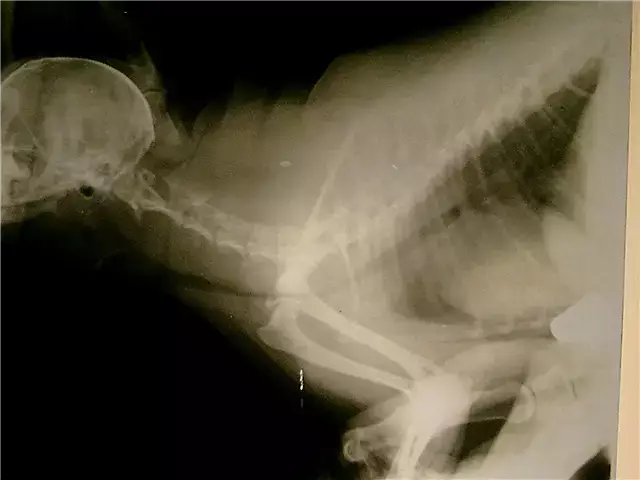- Author Rachel Wainwright [email protected].
- Public 2023-12-15 07:39.
- Last modified 2025-11-02 20:14.
Eprex
Instructions for use:
- 1. Pharmacological properties
- 2. Release form
- 3. Indications for use
- 4. Contraindications
- 5. Instructions for use
- 6. Side effects

Eprex is an agent that stimulates the formation of red blood cells.
Pharmacological properties of Eprex
By nature, Eprex is a genetically engineered epoetin alfa glycoprotein. It belongs to the group of pharmacological agents that stimulate the formation of red blood cells - erythrocytes, and does not differ in properties from human erythropoietin.
The mechanism of action of the drug is that it stimulates the division and differentiation of erythrocyte precursors. This effect is selective, without affecting, for example, the formation of white blood cells - leukocytes. Studies have shown that Eprex has a slight ability to cause the formation of antibodies to it.
There is no evidence that Eprex is teratogenic or carcinogenic.
Release form
The drug is released in glass syringes in the form of an injection solution.
Indications for the use of Eprex
Eprex is used in the treatment of anemia in children and adults with chronic renal failure, in people with oncological pathology of non-myeloid origin (including for the prevention of anemia), in the case of anemia in people infected with HIV and receiving zidovudine in treatment.
If an operation with extensive blood loss in adults is planned against a background of mild or moderate anemia, then Eprex is used to prevent extensive blood transfusions in the future and restore the normal rate of erythrocyte formation.
Contraindications
Eprex should not be used in case of intolerance to its components, unregulated hypertension, severe vascular lesions of the heart, brain, including in patients who have recently suffered a heart attack or stroke. Pregnancy and lactation, as well as the inability to adequately prevent blood clots, are also a contraindication to Eprex.
If a patient with partial red cell aplasia has received any erythropoietin in treatment, the use of Eprex is not recommended.
Instructions for using Eprex
The drug is in sterile disposable syringes, it is intended for subcutaneous and intravenous administration.
Make sure that there are no visible particles in the liquid before use. The syringe should not be shaken - this can destroy the structure of epoetin alfa.
Intravenous administration is carried out for at least 1-5 minutes. Eprex must not be mixed with other drugs or given as an intravenous infusion.
For subcutaneous administration, the volume of infusion should not exceed 1 ml, if it is exceeded, it is necessary to inject the drug into several places. Typically, the thigh, shoulder, and abdominal wall are selected for subcutaneous administration.
During the course of drug therapy, the optimal blood hemoglobin level of 120 g / l (for any sex) should be achieved and not exceeded. During treatment, it is necessary to check the level of serum iron in the blood and, if it decreases, add iron preparations to therapy.

In case of oncological diseases, Eprex is prescribed for concomitant anemia, as well as to prevent its occurrence during the course of chemotherapy, if during the first course its hemoglobin decreased by more than 20 g / l. The initial dose of Eprex is 150 IU / kg 3 times a week, or 40,000 IU once a week.
If, after 4 weeks from the start of treatment, the patient's hemoglobin has risen by 10 g / l or more, and reticulocytes in the analysis are not less than 40,000 in 1 μl, then this confirms the correctness of the selected dose. If the control values are less than these figures, then the dose for the next 4 weeks should be increased to 300 IU / kg 3 times a week or 60,000 IU once a week.
If a sufficient increase in hemoglobin and reticulocytes is achieved at this dose after 4 weeks of treatment, the dosage is considered sufficient, and they stop at it. If the increase in hemoglobin and reticulocytes at an increased dose is less than the recommended values, then the treatment is stopped.
If the increase in hemoglobin is more than 20 g / l per month or the desired level of 120 g / l is reached, the dose of Eprex must be reduced by 25%. If the hemoglobin content of blood exceeds 120 g / l, treatment with epoetin alfa is temporarily suspended, and resumed after a decrease in hemoglobin below 120 g / l in a dose 25% less than the initial one. The administration of Eprex continues for 1 month after the end of chemotherapy.
When collecting blood before a planned major surgery, Eprex is administered intravenously after the end of blood collection. In this case, it is prescribed 2 times a week for 3 weeks in a row; at each visit to the doctor, a portion of blood is taken from the patient and stored for transfusion to the same patient. Dose of Eprex 600 IU / kg 2 times a week.
For patients who are planning an operation, but do not participate in the autologous blood collection program, as well as if the operation has already been performed, Eprex is injected subcutaneously 600 IU / kg / week, 3 weeks in a row.
Side effects
Eprex can cause such undesirable effects as dizziness, fever, joint pain and headaches, weakness, increased pressure, convulsions, allergic reactions in the form of rashes, itching, urticaria or angioedema. Local reactions can be associated with the injection site, and manifest as burning, redness, moderate pain at the injection site.
Information about the drug is generalized, provided for informational purposes only and does not replace the official instructions. Self-medication is hazardous to health!






